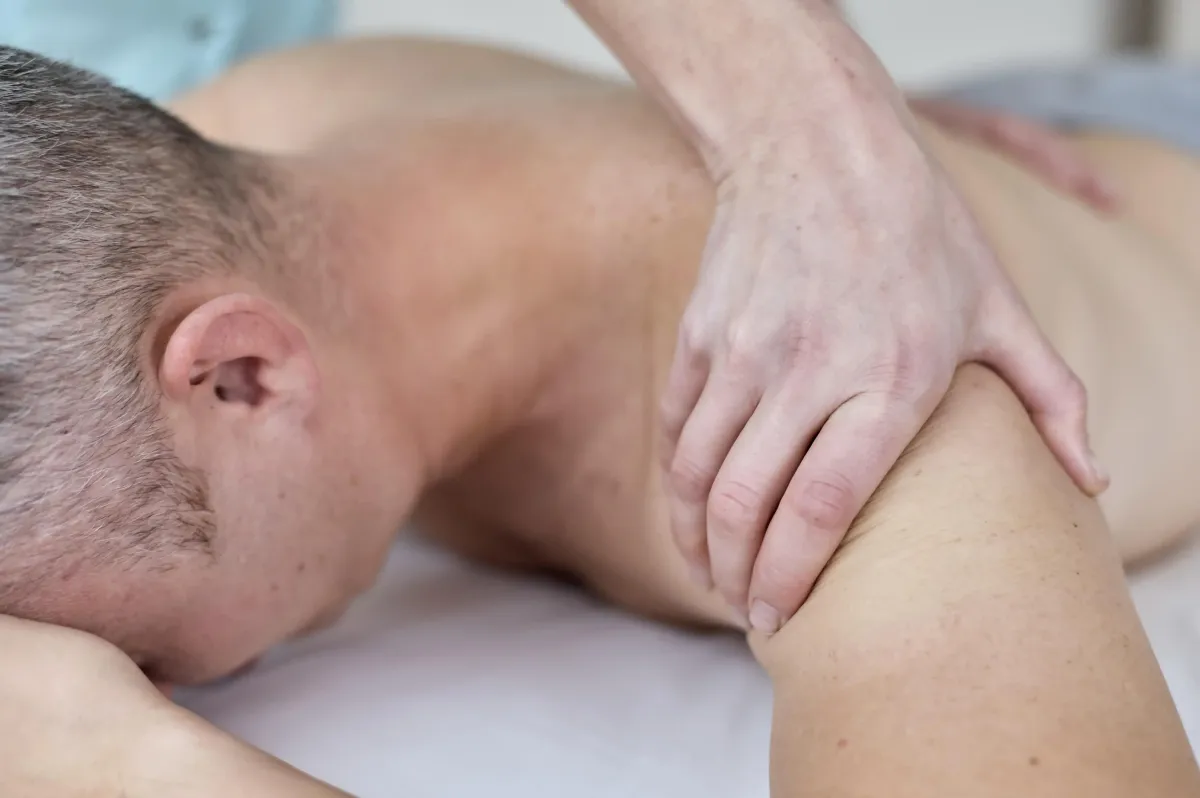Myofascial Release Therapy in New Jersey
Clifton Physical Therapy

What Is Myofascial Release Therapy?
Myofascial release therapy is a manual technique that focuses on the fascial system — the web-like connective tissue that surrounds your muscles, bones, and organs. When this tissue becomes tight or restricted, it can limit your mobility and cause pain in more than one area of the body.
During treatment, the therapist applies slow, sustained pressure to areas that feel tight or rigid. This helps soften the fascia, improve movement, and reduce discomfort. Patients in Clifton often choose this therapy when daily tasks, work responsibilities, or recreational activities become difficult due to stiffness or lingering pain.
What Is Fascia and Why Does It Matter?
Fascia acts as a continuous protective layer that supports your muscles and helps your body move efficiently. You can think of it as a connected network that links your entire system together. Because it moves as one piece, tension in one area — such as the hips, back, or neck — can affect completely different regions.
Healthy fascia stretches and glides easily. But after injury, surgery, repetitive activity, or inflammation, it can thicken and lose flexibility. This leads to limited mobility, soreness, and tightness that can make simple activities uncomfortable. Myofascial release aims to restore that natural movement so your body feels balanced and supported again.
Is Myofascial Release the Same as Trigger Point Therapy?
Myofascial release and trigger point therapy are closely related because they both address tight, sensitive spots in the connective tissue. These spots — often referred to as knots — can restrict movement and send pain to other parts of the body.
Trigger points commonly develop in people who sit for long hours, deal with repetitive strain, or have postural imbalances. By gently releasing these restricted areas, the therapy helps restore healthier movement patterns and reduces pain. Many Clifton patients find that combining both methods leads to faster, longer-lasting relief.
Who Can Benefit From Myofascial Release Therapy?
Myofascial release is suitable for a wide range of patients, especially those dealing with pain, limited mobility, or chronic tension. At Clifton Physical Therapy, individuals often seek this treatment for:
Injuries from falls, sports, or accidents
Post-surgical or post-injury scarring
Inflammatory conditions, including plantar fasciitis or bursitis
Nerve compression, such as symptoms related to herniated discs or carpal tunnel
Repetitive strain from work, lifting, or poor posture
What Conditions Does Myofascial Release Therapy Help Treat?
Myofascial release therapy supports recovery from a wide range of musculoskeletal issues—especially conditions involving stiffness, restricted movement, or chronic tension.
Myofascial pain syndrome:
This condition involves tight, sensitive trigger points within the fascia that create deep, aching discomfort. Myofascial release helps soften these irritated areas, reduce referred pain patterns, and restore normal muscle elasticity.
Carpal tunnel–related symptoms:
Tight fascia in the wrist, palm, and forearm can compress nearby nerves, worsening numbness, tingling, or hand weakness. By easing fascial restrictions, therapists help improve nerve glide and reduce the strain on the carpal tunnel.
Lower back pain:
Restrictions in the lumbar fascia, glutes, or hip region can limit spinal movement and place extra stress on the lower back. Myofascial release helps loosen these interconnected tissues, improve mobility, and relieve mechanical pressure that contributes to chronic pain.
TMJ-related tension:
Tight or overworked muscles and fascia in the jaw, neck, and shoulders can lead to jaw soreness, headaches, or difficulty opening the mouth fully. Gentle fascial work helps restore balance to these areas and supports smoother jaw mechanics.
Fibromyalgia:
People with fibromyalgia often experience widespread tenderness and sensitivity. Myofascial release uses gentle pressure to reduce overall stiffness, improve circulation in painful areas, and make everyday movement more tolerable during flare-ups.
Chronic migraines or tension headaches:
Fascial restrictions in the upper back, shoulders, and neck can contribute to recurring headaches by increasing muscular tension and limiting blood flow. Releasing these tight areas may help decrease the intensity and frequency of migraines or tension-type headaches.
What Should You Expect After a Myofascial Release Session?
Mild soreness is common after a session—especially if the treated tissues were very tight—yet most patients notice a sense of lightness and improved motion soon after. This soreness usually fades quickly.
For meaningful, long-lasting results, consistency matters. Depending on your condition, your therapist may recommend sessions every one to three days at the beginning. Treatments typically last between 15 and 50 minutes.
How Does Myofascial Release Work?
During treatment, your therapist applies slow, controlled pressure to areas where the fascia feels restricted. Unlike general massage, the goal isn’t to knead the muscles but to gently stretch and soften the connective tissue.
As the fascia releases, circulation improves, muscle tension decreases, and joint movement becomes easier. Many patients who spend long hours sitting, driving, working on computers, or staying active benefit from the way this therapy restores natural movement patterns.
Common Techniques Used at Clifton Physical Therapy
Our therapists use a variety of proven methods to relieve fascial tension. Your individualized plan may include one or more of the following:
Instrument-Assisted Soft Tissue Mobilization (IASTM)
This technique uses specialized tools to break down adhesions, reduce scar tissue buildup, and improve soft-tissue mobility. It’s especially helpful for chronic tightness or old injuries.
Active Release Techniques (ART)
ART blends targeted pressure with guided patient movement to release adhesions caused by repetitive strain. This method is highly beneficial for people experiencing nerve-like symptoms or muscle fatigue from repetitive tasks.
Direct Myofascial Release
A slow, sustained pressure applied directly to restricted fascial layers to lengthen and soften the tissue. This approach is more focused and specific than general deep-tissue massage.
Indirect Myofascial Release
A gentle technique that guides the fascia toward positions of ease until the tissue naturally releases. It’s ideal for sensitive or highly inflamed areas.
Stretching-Based Techniques
Your therapist may use controlled stretching to improve flexibility in both the fascia and underlying muscles, helping restore healthier movement patterns.
Positional Release Technique
A method that positions the body in comfortable, supported postures to reduce muscle tension and reset dysfunctional movement patterns.
Self-Myofascial Release Training
Patients often learn how to use foam rollers, massage balls, or simple tools to maintain fascial mobility between appointments—perfect for at-home care.
Source: Physiopedia
What Real Patients Say About Myofascial Release Therapy
“After just one focused session, I felt relief that lasted for days—something I hadn’t experienced with stretching alone.”
Source: Reddit – r/ChronicPain
“Working with both a PT and a massage therapist using myofascial release was challenging at first, but the improvements were worth it.”
Source: Reddit – r/Fibromyalgia
“Combining pool therapy, TENS, and myofascial release helped reduce fatigue and made movement feel easier.”
Source: Reddit – r/Fibromyalgia
“My jaw and neck tension started to ease after releasing trigger points linked to TMJ issues. It was uncomfortable at first, but the relief was real.”
Source: Reddit – r/TMJ
Call us at (973)-241-1338 to book your appointment today.
What others are saying
"I recently had ankle surgery and Clifton PT has been nothing short of amazing! My goal was to get back to playing soccer as quick as possible before the college season started and so far I'm right on track. Izzy, Bianca, Tiff, and John have gone above and beyond to make sure I'm back to 100%. Couldn't be more grateful to be treated by the best team ever!." - Nat Rufino

All the therapists at Clifton Physical Therapy are awesome, but I spend most of my time with Izzy and Bianca—and they’ve been amazing. They’re enthusiastic, knowledgeable, and always take the time to explain what I’m doing and what my issues are. Their positive energy and clear communication make a big difference in my recovery." - Bryan Tompkins

"Going Clifton physical therapy was one of the best thing that came out of my back pain! Every single staff member is amazing and cares for your recovery! I have been with them for the past couple of months and now continuing their workout program! I can’t recommend them enough! Tiffany, Izzy, Bianca and everyone else I have worked with there! Can’t rave about them enough!!." - Monica Mehta

"Clifton Physical Therapy has been a great place for me to heal my meniscus tear. The staff is very knowledgeable and friendly, and has been extremely helpful in guiding me through my recovery. I highly recommend their services.." - Kelly Bevando

Clifton Physical Therapy
✆ Phone (appointments): (973)-241-1338
Address: 1059 Bloomfield Ave, Clifton, NJ 07012
